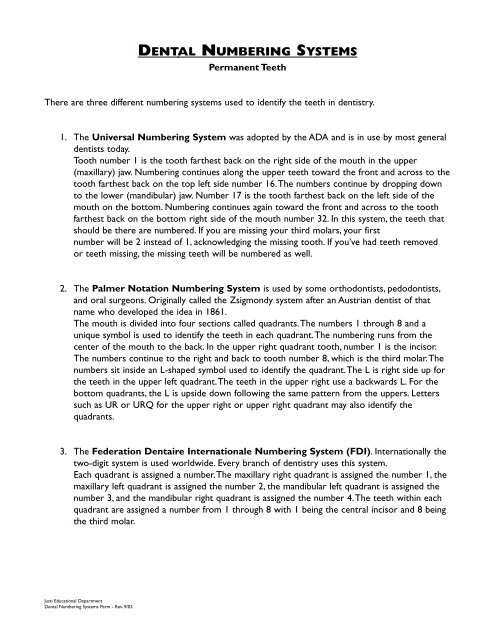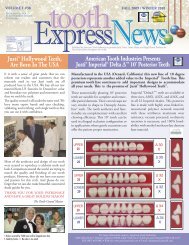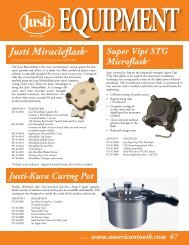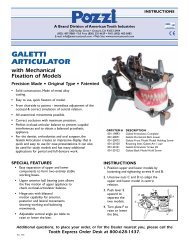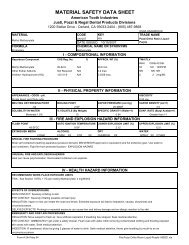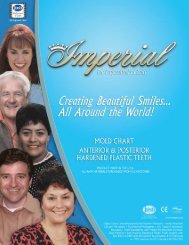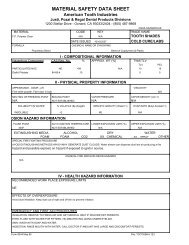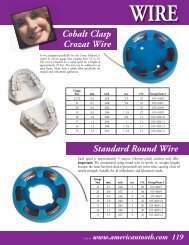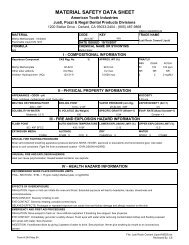DENTAL NUMBERING SYSTEMS PERM - American Tooth Industries
DENTAL NUMBERING SYSTEMS PERM - American Tooth Industries
DENTAL NUMBERING SYSTEMS PERM - American Tooth Industries
Create successful ePaper yourself
Turn your PDF publications into a flip-book with our unique Google optimized e-Paper software.
<strong>DENTAL</strong> <strong>NUMBERING</strong> <strong>SYSTEMS</strong><br />
Permanent Teeth<br />
There There are are three three different different numbering systems systems used used to identify to identify the the teeth teeth in dentistry. in dentistry.<br />
1.The The Universal Numbering System Systemhas was been adopted adopted by the by the ADA ADA and and is in is use in use by most by most general<br />
general dentists dentists today. today.<br />
<strong>Tooth</strong> <strong>Tooth</strong> number number 1 is 1 the is the tooth tooth farthest farthest back back on the on the right right side side of your of the mouth in in the the upper (maxillary)<br />
(maxillary) jaw. Numbering jaw. Numbering continues continues along your along upper the teeth upper toward teeth toward the front the and front across and to across the to the<br />
tooth tooth farthest farthest back back on the on the top top left left side side number number 16.The 16.The numbers numbers continue continue by dropping by dropping down down<br />
to the to the lower lower (mandibular) jaw. jaw. Number Number 17 is 17 the is the tooth tooth farthest farthest back back on the on the left left side side of your of the<br />
mouth mouth on the on the bottom. bottom. Numbering continues again again toward toward the the front front and and across across to the to the tooth tooth<br />
farthest farthest back back on the on the bottom bottom right right side side of you of the mouth mouth number number 32. 32. In this In this system, system, the the teeth teeth that that<br />
should should be there be there are are numbered. If you If you are are missing missing your your third third molars, molars, your your first first number will be 2<br />
instead number of 1, will acknowledging be 2 instead the of 1, missing acknowledging tooth. If you’ve the missing had teeth tooth. removed If you’ve or had teeth teeth missing, removed<br />
the or missing teeth teeth missing, will the be missing numbered teeth as will well. be numbered as well.<br />
2.The The Palmer Notation Numbering System Systemis is used by by some orthodontists, pedodontists,<br />
and and oral oral surgeons. Originally called called the the Zsigmondy system system after after an Austrian an Austrian dentist dentist of that of that<br />
name name who who developed the the idea idea in 1861. in 1861.<br />
The The mouth mouth is divided is divided into into four four sections sections called called quadrants.The numbers numbers 1 through 1 through 8 and 8 and a a<br />
unique unique symbol symbol is used is used to identify to identify the the teeth teeth in each in each quadrant.The numbering runs runs from from the the<br />
center center of the of the mouth mouth to the to the back. back. In the In the upper upper right right quadrant tooth, tooth, number number 1 is 1 the is the incisor. incisor.<br />
The The numbers numbers continue continue to the to the right right and and back back to tooth to tooth number number 8, which 8, which is the is the third third molar.The<br />
numbers numbers sit inside sit inside an L-shaped an L-shaped symbol symbol used used to identify to identify the the quadrant.The L is L right is right side side up for up for<br />
the the teeth teeth in the in the upper upper right left quadrant.The teeth in in the the upper left right use use a backwards a backwards L. For L. For the the<br />
bottom bottom quadrants, the the L is L upside is upside down down following the the same same pattern pattern from from the the uppers. uppers. Letters Letters<br />
such such as UR as UR or URQ or URQ for for the the upper upper right right or upper or upper right right quadrant may may also also identify identify the the quadrants.<br />
quadrants.<br />
3.The The Federation Dentaire Internationale Numbering System (FDI). Internationally the<br />
the two-digit two- digit system is is used worldwide. Every branch of of dentistry uses this system.<br />
Each Each quadrant is assigned is assigned a number.The a number.The maxillary right right quadrant is assigned is assigned the the number number 1, the 1, the<br />
maxillary left left quadrant is assigned is assigned the the number number 2, the 2, the mandibular left left quadrant is assigned is assigned the the<br />
number number 3, and 3, and the the mandibular right right quadrant is assigned is assigned the the number number 4.The 4.The teeth teeth within within each each<br />
quadrant are are assigned assigned a number a number from from 1 through 1 through 8 with 8 with 1 being 1 being the the central central incisor incisor and and 8 being 8 being<br />
the the third third molar. molar.<br />
Justi Educational Department<br />
Dental Numbering Systems Perm - Rev. 9/03
(R) Second<br />
Bicuspid<br />
(R) First<br />
Molar<br />
(R) Second<br />
Molar<br />
(R) Third<br />
Molar<br />
(R) Third<br />
Molar<br />
(R) Second<br />
Molar<br />
(R) First<br />
Molar<br />
(R) First<br />
Bicuspid<br />
17<br />
18<br />
FDI<br />
48<br />
(R) Second<br />
Bicuspid<br />
16<br />
47<br />
15<br />
46<br />
(R) First<br />
Bicuspid<br />
(R) Cuspid<br />
45<br />
14<br />
8<br />
7<br />
Justi Educational Department<br />
Dental Numbering Systems Perm - Rev. 9/03<br />
<strong>DENTAL</strong> <strong>NUMBERING</strong> <strong>SYSTEMS</strong><br />
7<br />
8<br />
PALMER<br />
6<br />
6<br />
44<br />
5<br />
5<br />
(R) Cuspid<br />
(R) Lateral<br />
Incisor<br />
13<br />
4<br />
2<br />
1<br />
32<br />
31<br />
4<br />
3<br />
UNIVERSAL<br />
43<br />
30<br />
12<br />
3<br />
4<br />
5<br />
29<br />
28<br />
3<br />
(R) Lateral<br />
Incisor<br />
6<br />
2<br />
42<br />
<strong>PERM</strong>ANENT<br />
ERMANENT TEETH EETH<br />
(R) Central<br />
Incisor<br />
7<br />
RIGHT<br />
27<br />
11<br />
1<br />
8<br />
2<br />
26<br />
ILLUSTRATED<br />
Upper<br />
(maxillary)<br />
Lower<br />
(mandibular)<br />
41<br />
(R) Central<br />
Incisor<br />
1<br />
25<br />
24<br />
9<br />
1<br />
1<br />
31<br />
23<br />
21<br />
LEFT<br />
2<br />
(L) Central<br />
Incisor<br />
(L) Central<br />
Incisor<br />
10<br />
22<br />
2<br />
11<br />
32<br />
21<br />
12<br />
17<br />
18<br />
19<br />
20<br />
3<br />
22<br />
3<br />
13<br />
14<br />
15<br />
16<br />
4<br />
4<br />
UNIVERSAL<br />
(L) Lateral<br />
Incisor<br />
(L) Lateral<br />
Incisor<br />
5<br />
33<br />
23<br />
5<br />
6<br />
6<br />
7<br />
24<br />
8<br />
PALMER<br />
8<br />
7<br />
(L) Cuspid<br />
34<br />
25<br />
35<br />
(L) First<br />
Bicuspid<br />
26<br />
27<br />
38<br />
37<br />
36<br />
(L) Cuspid<br />
28<br />
(L) Second<br />
Bicuspid<br />
FDI<br />
(L) First<br />
Molar<br />
(L) Second<br />
Molar<br />
(L) Third<br />
Molar<br />
(L) Third<br />
Molar<br />
(L) Second<br />
Molar<br />
(L) First<br />
Molar<br />
(L) Second<br />
Bicuspid<br />
(L) First<br />
Bicuspid<br />
2


